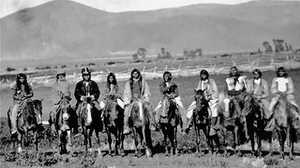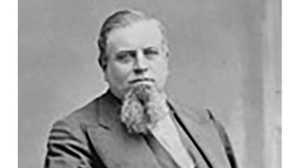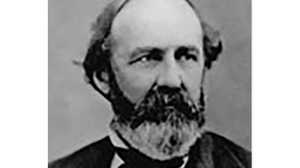Scouting the Route

1. In the Sierra Nevada, California
This is an old fire lookout in the Sierras. It took us about an hour to four-wheel to up to this summit and I was pretty sure we were going off the edge of a cliff half a dozen times... But our trusty guides, Chris Graves, Dana Scanlon and Robert Chugg piloted us through. From the view, you get a look at the kind of landscape the Central Pacific had to work through. It was a lot easier to get over these mountains in a helicopter.
2. Donner Lake, California
This is a view of Donner Lake from the eastern end of Summit Tunnel. We are, in fact, standing on top of the 1,659-foot tunnel looking east. The tunnel itself is abandoned now. The highlight of the drive that day was stopping at a little park near the lake, where the picnic tables were uncomfortably close to a Donner Party memorial.
3. Western Nevada Desert (1)
This is in the western Nevada desert, a long drive from where we'd seen the last of the Truckee River, in the summer of 2001. The abandoned wooden trestle is one of about six we saw that day. We're about twenty miles from the nearest paved road... driving on the original grade, long since abandoned. We went the entire day without seeing another human being. Which wasn't always a bad thing, especially for our camera assistant, Jill Tufts, because we also didn't see indoor plumbing for a few days either. We suffered the fourth of our five flat tires that day.
4. Western Nevada Desert (2)
When the Central Pacific needed to build fast and cheap they didn't bother to fill, but just tossed up these trestles and never bothered to shore them up later. Along the grade, there is evidence of dozens of little dugouts -- maybe three feet deep and five feet in diameter -- where the Chinese workers took some measure of shelter from the winds. To this day the ground yields artifacts the Chinese workers left behind more than a century before.
5. Eastern Nevada Desert (1)
There's plenty of evidence of the old line, the grade, trestles, culverts, piles of abandoned ties. The towns that dotted the lines are all gone to dust now.
6. Eastern Nevada Desert (2)
It took us three hot August days to get across Nevada -- drinking water by the gallon. It took the men building this railroad more than a year to cross Nevada, living outdoors, through blazing hot days and cold desert nights. And they had to haul all the water by train from the Truckee River, hundreds of miles behind them. The foremen talked about losing mules by the dozen to heat stroke. Even today, you'll find the bleached bones of dead cattle.
7. Near the Great Salt Lake
We saw some big cuts at the north end of the Great Salt Lake, not far from the Promontory meeting spot. This one is near the place where the UP and CP grading crews had crossed and were grading two separate lines side by side.
8. Promontory Summit, Utah
Promontory, where the trains met. Today it's a national park with two exquisite replicas of the trains that met the May day in 1869. We spent a lot of time shooting in and around those big steam engines. What I remember most was how elemental they were -- fire, water, iron and air, breathing and hissing like some great living beasts. Being in the cab next to the engineer -- and next to the big boiler -- gave me a real idea about how men got cooked to death in train wrecks.
9. Ogden, Utah
Union Station, Ogden, Utah, now a museum. This was the switching point for the Union Pacific and the Central Pacific, and in its heyday in the early 20th century home to three separate major railroads, employing vast numbers of men. In fact, the companies had to agree to have separate paydays so local banks didn't have to cash all the checks on the same day. Legend has it that the railroad men would cash their check, meet their wives outside the station, hand over half the loot, and take the rest to the local red light district, conveniently located just steps away.
10. Echo, Utah
Eastern Utah was certainly one of the hardest spots for the UP to get through, because of the canyons. The earth is very red there and I remember how beautiful it looked in contrast with the green.
11. Piedmont, Wyoming (1)
There are ruins of dozens of little towns all along the original line. Steam engines needed water constantly, so every twenty miles the railroads stopped and planted a water-tower and a telegraph station and more or less called it a town. Some grew into towns, some didn't.
12. Piedmont, Wyoming (2)
In Nevada especially, along the long-abandoned original line, we'd find spots where the only traces of a town were a few foundations sprouting weeds and a graveyard with four or five markers to the people who had the bad fortune to die there.
13. Near Green River, Wyoming (1)
In this area we could see the entire history of Anglo-travel in the American west. There was the river itself, an old stage road, the railroad, the interstate highway, and the jets overhead. Green River is where John Wesley Powell began his exploration of the Colorado River and where we narrowly avoided a speeding ticket by the good graces of a kindly law enforcement officer.
14. Near Green River, Wyoming (2)
I was born in western Kansas, so some of my first memories are of wide-open prairies and jackrabbits. It was great to be out there in the big sky.
15. Point of Rock, Wyoming
The area around Green River, Wyoming, had some of the most spectacular landscapes we'd seen -- we spent a lot of time four-wheeling to the highest spots for the view. Up there it was just us and the rattlesnakes, which were ubiquitous by sound, if not sight. This picture shows the old overland stagecoach route.
16. Sherman, Wyoming
Ames Monument. This is just off the interstate midway between Cheyenne and Laramie, at the ghost town of Sherman, Wyoming. Sherman is the highest point on the transcontinental railroad, at more than 8000 feet. But it was a slow easy climb and a walk in the park compared to what the Central Pacific had to cut through in the Sierras. Locals say that Sherman is also the windiest spot in the continental United States, and after a few visits, I'm in no position to argue. We needed sweaters... in July, and parkas in November. There is still considerable railroad traffic near Sherman and we spent a lot of hours filming trains there. But because of the wind, we had to rent an extra-sturdy tripod just to keep the camera steady.
17. Dale Creek, Wyoming
This is the spot, near Sherman, Wyoming, where stood the Dale Creek Bridge. The original bridge, completed in 1868, was all wood, pre-fabricated in Chicago and shipped to Wyoming. The thing was so rickety -- and Sherman so windy -- that engineers used to hold their breath and pray as they crossed it at the prescribed speed of about 4 mph.
18. Dix, Nebraska
You get a sense how easy it was for the Union Pacific to lay tracks across the flat Nebraska prairie. The only real complication was the lack of hardwood trees for making proper ties. The cottonwoods that line the Platte River were just too soft, but much of northern Nebraska was deforested in the effort.
19. Julesberg, Colorado
The line ducks down into Colorado at Julesburg, a town that was in about three different locations in its history. The town was wiped out by Indians at one point and moved. Then it burned, and was moved again. Julesburg boasts Boot Hill Cemetery, where Jack Casement had some of his men ice the ne'er-do-wells in town who tried to take over UP land.
20. Roscoe, Nebraska
Grain elevators dot the line through Nebraska -- it's still such good farmland. The farther west you get, the tougher agriculture gets as you approach the desert.
21. North Platte, Nebraska
North Platte, a town built by the Union Pacific Company, is still a railroad town, and along with Cheyenne, one of the busiest we saw. The North Platte station is lined with freight trains heading east and west, day and night.
22. Brady, Nebraska
You see very few passenger trains, mostly freights. I remember we once just happened on this huge freight train that was switching off an engine. We talked to the engineers who told us they were carrying I can't remember how many thousands of tons of chicken feed. It reminded us how much that economy still really works.
23. Shelton, Nebraska
The flat Nebraska prairie presented little difficulty for UP crews, which included many Civil War veterans. The real obstacles were the people who saw themselves as the stewards of the land: the Northern and Southern Cheyenne Indians, the Sioux and the Arapaho.
24. Omaha, Nebraska
The downtown area of Omaha is quite lovely and after a long time on the road it was nice to get back to civilization again. We ate a memorable meal in Omaha.







